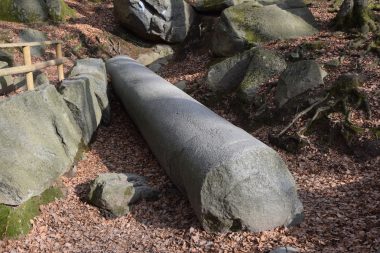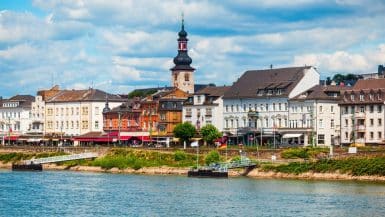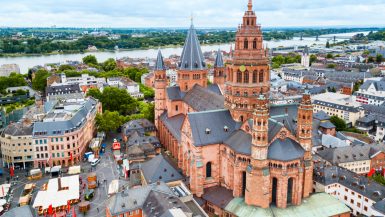The Felsenmeer in the Vorderer Odenwald is one of the most impressive places and the most popular local recreation areas for hikers and families in the region. One side of the 514 m high rocky mountain is dominated by a wide swath that resembles a petrified sea of waves in a storm. The slope is covered all over with rounded granite blocks, which give the impression that a gigantic avalanche has gone off here at some point.

The fantastic rocky landscape was created by weathering. Various chemical and physical processes gave rise to the countless rounded granite rocks made of dark green quartz diorite, which are reminiscent of pillows and woolsacks. These rounded shapes also gave the weathering type its name – it is called woolsack weathering.
The unique rocky landscape is located in the nature reserve “Felsberg bei Reichenbach” and is part of the Natura 2000 project. In 2017, the new information centre of the Geopark opened on the territory of the municipality of Lautertal. It is usually the first point of contact for all foreign and local visitors. In addition to parking spaces, sanitary facilities and a bistro with beer garden, a library is also available to interested parties in the rooms. From time to time, informative exhibitions and slide shows take place here.
The Felsenmeer and the Romans
The Romans already used the Felsenmeer as a kind of quarry and worked the rocks. To date, 15 of their workstations have been found, with a total of almost 300 unfinished workpieces. It is not known exactly from which time these unfinished legacies originate, as no tools or everyday objects were discovered on site that allow exact conclusions. Scientists, however, commit themselves to the period between the second and fourth centuries.
The most important and closely studied object left behind by the Romans is the 9.3 m long giant column, which makes a finished impression. It weighs around 27.5 t and it was found that parts of this column were used on extremely prominent buildings. For example, the famous cathedral stone at Trier Cathedral was separated from this column, as was the material for the water basin at Mainz’s Schillerplatz and the columns in the inner courtyard of Heidelberg Castle. The other stones made of Felsberg granite, found in the Lautertal Felsenmeer and hewn by the Romans, have names such as pyramid, altar stone, ship, coffin and circular plate. You can >> download more information about the column here
Hiking at the Felsenmeer

The Felsenmeer Lautertal is just as worthwhile a destination for nature and hiking enthusiasts as it is for people interested in history. On the summit of the Felsberg is the Ohlyturm, a 27 m high observation tower that is considered the landmark of the mountain. It was built at the end of the 19th century, initially from wood and in 1902 from granite. The tower was named after a former mayor of Darmstadt. It is a typical example of historicist architecture and is modelled on the romantic castles of the Middle Ages. A nice end point for a hike through the dense beech and conifer forest is also the Siegfried Spring, which is located at the foot of the Felsenmeer. This is one of the places where the killing of the Nibelungen hero could possibly have taken place. A variety of different hiking routes lead through the Odenwald and also through the Felsenmeer Geopark, including Nibelungen theme trails. In addition, guided tours are regularly offered especially for families with children, which are anything but boring, and the exciting rallies always ensure enthusiasm among the youngsters. There are a total of 18 rocky seas on this mountain. The most important of them is a listed building and stretches from the site where the giant column was found to the Lochwiese.
The Felsenmeer Lautertal is ideal for a beautiful excursion that combines physical exercise in the fresh air and exciting discoveries.
General information
The Felsenmeer is located in the Lauter Valley in the Odenwald, between the towns of Reichenbach and Elmshausen. It is a natural monument and one of the most famous geological sights in Germany. The rock formations were formed by natural erosion processes that began millions of years ago.
Geology
The Felsenmeer is characterized by huge quartz diorite blocks, which came to the surface in the course of the earth’s history through weathering processes. These rock formations not only offer a spectacular picture, but also tell the geological history of the region.
Sights
- The Giant Block: One of the largest and most impressive boulders in the Felsenmeer.
- Roman quarry: Historical remains from the Roman era that show how stones were mined for construction purposes.
- Felsenmeer Information Centre: Offers exhibitions and information on the geology, flora and fauna of the region, as well as on the use of the Felsenmeer by humans throughout history.
Activities
- Hiking: There are several hiking trails that lead through the Felsenmeer and have different levels of difficulty.
- Climbing: The Felsenmeer is also popular with climbers, who use the boulders as natural climbing walls.
- Photography: The unique landscape offers numerous motifs for impressive nature photographs.
- Learn and Discover: Guided tours and educational programs help visitors learn more about the geological and historical aspects of the Felsenmeer.
Best time to visit
The Felsenmeer can be visited all year round, but the best time to visit is from spring to autumn, when the weather is milder and the natural beauty of the surroundings is at its best.
Journey
The Felsenmeer Lautertal is easily accessible by car. It is located about an hour south of Frankfurt am Main. There is parking near the entrance from which visitors can walk to the rocks.




